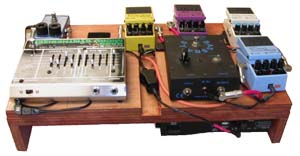Guitar pedalboard
This article needs additional citations for verification. (January 2021) |

A guitar pedalboard is a flat board or panel that serves as a container, patch bay, and power supply for effects pedals for the electric guitar. Some pedalboards contain their own transformer and power cables to power multiple pedals. Pedalboards help the player manage multiple pedals. The entire pedalboard can be packed up and transported to the next location without disassembly.
Pedalboards often have a cover that protects the effects pedals during transportation. There are many varieties of pedalboard cases, including homemade do it yourself pedalboard cases, store-bought pedalboard cases, and custom-made pedalboard cases. Hard shell pedalboard-cases have foam padding, reinforced corners, and locking latches. During performance, with the lid removed, the bottom of the case is a pedalboard. Most pedalboards have a flat surface where pedals and their power supplies attach using hook-and-loop fasteners or other techniques, and often have a removable lid or padding to protect the pedals when not in use. Some pedalboards have handles or wheels to facilitate transportation.[1]

Pedal power supply
[edit]Most effects pedals are powered by varying levels of DC voltage, depending on the manufacturer. Possible voltages include 9V, 12V, 15V, 18V, 24V, and 40V, though 9V center negative is most common. Some effects pedals accept a range of voltages, producing different effects. Guitar players can experiment with varying voltages to generate different sounds.
DC power can be generated by batteries, an AC/DC power supply, or a rechargeable battery. Each has its own advantages and disadvantages.
Using individual batteries is fine for occasional players, because they don't have to worry about the cost of replacement batteries or changes in sound as batteries get tired. Battery life varies depending on the pedal's power draw. Professional players normally replace all batteries with new ones before a show.
A DC power supply has higher initial cost, however, one must pay attention to noise from ground loops, switched-mode power supply's switching, and power line hum. Noise gates can be used to eliminate noise when not playing by suppressing any signal below a certain volume threshold, but can't actually remove noise from the desired audio signal while playing. Switched-mode power supply noise can be reduced with low-pass filtering and a regulator, and by ensuring the switching frequency is significantly higher than the ~20 kHz upper limit of human hearing. Power line hum can be reduced by increasing the distance between the power supply transformers and the pedals or by shielding the pedals.
Additionally, some power supplies galvanically isolate each pedal's voltage supply, which eliminates ground loops between each pedal and whatever it connects to.

Some power supplies have a powerful rechargeable battery can be used to drive all the pedals, and a battery charger to recharge the battery. There are batteries on the market that can power over 20 effects pedals for eight hours on a single charge.
Using a rechargeable effects pedal battery or AC/DC power supply in conjunction with a “pedalboard suitcase” reduces setup time prior to a show.
See also
[edit]References
[edit]- ^ Cleveland, Barry. "Pedalboards: How to Build the Perfect System from Start to Finish". GuitarPlayer.com. Future US Inc. Retrieved 16 December 2020.
External links
[edit]- "Chairmen of the Boards". Guitar Player. May 1, 2008.
- "Guitar Pedal Guides"
